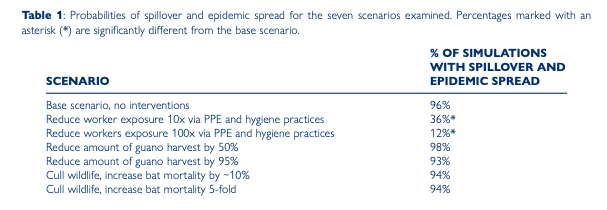$1mln question: What was going on in that abandoned mine?
This is the $1mln question still without an answer: why were these workers cleaning bat guano from that abandoned mine?
Surprisingly we simply don't know.
China would have all interest in clarifying that point if for instance they were prospecting or selling guano. It did not.
What we know is that EcoHealth + WIV were sampling bat sites in the vicinity at the exact time of the workers being in that mine.
#DRASTIC wrote about this and about other oddities in the official story:
bit.ly/3anAlg1
@gumby4christ
Maybe it's just one of these coincidences.
Then it gets interesting: about a year after the miners death, Olival & Epstein from EcoHealth Alliance co-authored a paper about the coronavirus risk infection from bat guano collection.
No mention of the mine
doi.org/10.3201/eid190…
That paper oddly used some old bat samples collected by DARPA in 2006/7 at the famous Thai bat cave.
It never mentioned that the Thai monks have been doing this every Sunday for many many years without infection.
reuters.com/article/us-hea…
But most interestingly it never mentioned the Mojiang mine accident, even if the perfect timing and recycling of old DARPA bat samples seem to point to a likely knowledge of it.
Anyway, the idea was to ask for more money, as you correctly guessed.
bit.ly/3jQ1Odo
So here comes a very handy scenario of a major coronavirus outbreak with a very 'scientific' and precise estimate of 96% of risk..
Again, please do not mention that the Thai monks have been doing this every Sunday for ages, you would spoil the fun.
bit.ly/3jQ1Odo 
Now that paper co-authored by EcoHealth had Supaporn Wacharapluesadee as main author.
Supaporn conveniently jumped back into the fray a few days ago with a Nature article pointing to batcovs in bats and pangolins in SE Asia:
nature.com/articles/s4146…
Leave these poor pangolins in peace please. The debate is closed there.
As for the bats coronavirus mentioned they are actually fairly distant from SARS-CoV-2, much more than Yunnan ones, and do not bind to hACE2 - so nothing particularly new.
bbc.com/news/science-e…
That Thai batcov article ended up being misused in a way that would support the China/Daszak narrative:
So the more you dig into this, the more the Mojiang mine accident becomes a key element.
Many of the odd silences and odd coincidences all link back to it.
I wish EcoHealth could tell us a bit more about it and their 2013 bat guano epiphany.
A job for @USRightToKnow.
As part of these weird coincidences I must add the amazing paper pushed to a pre-print site just on the day the small WHO mission arrived in Wuhan in Feb 20
A paper that had many things right so early on. It links back to that sampling trip in 2012